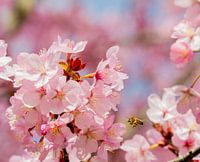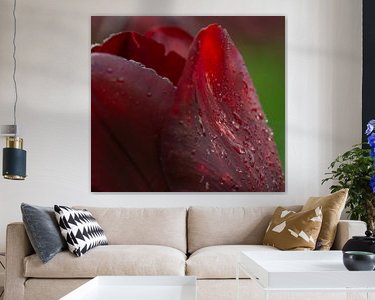Buy the photo Raindrops on Tulip by Stephan Scheffer on canvas, ArtFrame, poster and wallpaper, printed on demand in high quality.
About "Raindrops on Tulip"
by Stephan Scheffer
About the artwork
Tulips need a cold night and a cold winter to grow, so they cannot be grown in warm climates.
Over 75% of cultivated tulip bulbs are destined for flower production at home or abroad. The rest are sold to consumers as flower bulbs or end up in parks and public gardens.
New bulbs are grown by planting tulip bulbs in the autumn (October and November). The buds between the bulb skirts of these bulbs grow into new bulbs using the old bulb as food. The bud next to the growing point, known as the a-bud, grows into a large bulb that can be sold for flower production or directly to consumers. In addition to the a-bud, the planted bulb contains, between its bulb skirts, more small growth buds, called b-, c-, d- and e-buds, which grow into small bulbs (clisters). These clisters are attached to the large bulb, and are removed from the large bulb during summer peeling (removing the roots and old skin of the bulb). In the following autumn, they are planted in the field to grow into large bulbs. In this way, one maintains a batch of tulips: the large bulbs are used for flower production or sold directly to consumers and the small bulbs are planted in autumn.

About Stephan Scheffer
I love to go out into nature and do landscapes and macro photography.
and also likes to follow Workshops to create unique footage,
I would also be very honoured if my work were to hang on the wall at your place to add a little more colour to your interior...
Read more…
 Netherlands
Netherlands Ordered in January 2020
Ordered in January 2020
 Netherlands
Netherlands Ordered in April 2019
Ordered in April 2019
 Germany
Germany Ordered in November 2020
Ordered in November 2020
 Germany
Germany Ordered in March 2019
Ordered in March 2019
 Netherlands
Netherlands Ordered in August 2022
Ordered in August 2022
 Germany
Germany Ordered in June 2025
Ordered in June 2025
 Germany
Germany Ordered in July 2021
Ordered in July 2021
 Germany
Germany Ordered in October 2019
Ordered in October 2019
 Netherlands
Netherlands Ordered in February 2022
Ordered in February 2022
 Netherlands
Netherlands Ordered in September 2021
Ordered in September 2021
 Germany
Germany Ordered in February 2024
Ordered in February 2024
 Netherlands
Netherlands Ordered in November 2022
Ordered in November 2022
About the material
Wallpaper
Make a statement with art on wallpaper
- Razor-sharp prints
- Easy to apply
- Big sizes possible
- Strong quality
Discover the artworks of Stephan Scheffer
 Black and whiteStephan Scheffer
Black and whiteStephan Scheffer Long-eared owlStephan Scheffer
Long-eared owlStephan Scheffer Street in NewcastleStephan Scheffer
Street in NewcastleStephan Scheffer Tulips and MillStephan Scheffer
Tulips and MillStephan Scheffer European eagle owlStephan Scheffer
European eagle owlStephan Scheffer Steller's Osprey in flightStephan Scheffer
Steller's Osprey in flightStephan Scheffer Angry Red Kite.Stephan Scheffer
Angry Red Kite.Stephan Scheffer The West TowerStephan Scheffer
The West TowerStephan Scheffer A little tiredStephan Scheffer
A little tiredStephan Scheffer Sunset at the MolenkadeStephan Scheffer
Sunset at the MolenkadeStephan Scheffer Scottish HighlanderStephan Scheffer
Scottish HighlanderStephan Scheffer Female Scottish HighlanderStephan Scheffer
Female Scottish HighlanderStephan Scheffer Male Scottish HighlanderStephan Scheffer
Male Scottish HighlanderStephan Scheffer Close up Scottish HighlanderStephan Scheffer
Close up Scottish HighlanderStephan Scheffer Pink Blossom with a beeStephan Scheffer
Pink Blossom with a beeStephan Scheffer ( Cherry) BlossomStephan Scheffer
( Cherry) BlossomStephan Scheffer ( Cherry) Blossom in full bloomStephan Scheffer
( Cherry) Blossom in full bloomStephan Scheffer Look like an angelStephan Scheffer
Look like an angelStephan Scheffer Spoonbill with nesting materialStephan Scheffer
Spoonbill with nesting materialStephan Scheffer The endless path with colourStephan Scheffer
The endless path with colourStephan Scheffer













 Elegant Expressions
Elegant Expressions Macrophotography
Macrophotography Meadow
Meadow Photo wallpaper
Photo wallpaper Photography
Photography Rain
Rain Serene Peace
Serene Peace Tulip
Tulip Vibrant Colors
Vibrant Colors Waiting room
Waiting room









